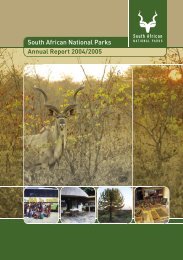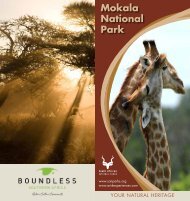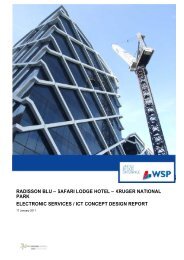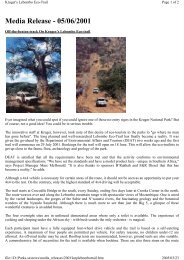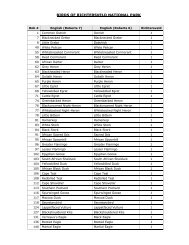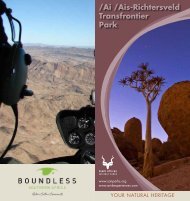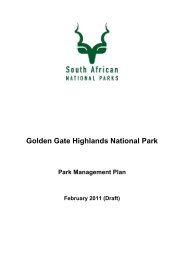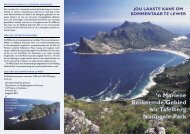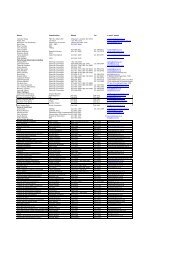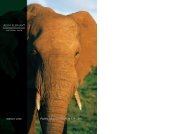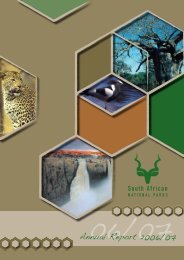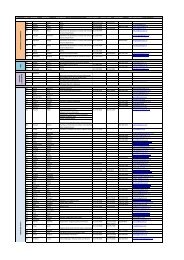<strong>2005</strong>South African National ParksCONSERVATION SERVICESLEGAL FRAMEWORK FORBIODIVERSITY CONSERVATIONAfter a decade of transformation with its debates concerning the mostappropriate way to go, biodiversity conservation is now accepted by<strong>SANParks</strong> as the bedrock of the organisation’s activities against whichother core functions such as tourism and people and conservation areanchored. <strong>SANParks</strong> has welcomed the refocus, and is now rolling out acorporate conservation leadership strategy.In September <strong>2005</strong>, Department of Environmental Affairs and Tourism(DEAT) took environmental law reform a step further by bringing into forcethe Protected Areas Act (57 of 2003 with its amendment, 31 of 2004).In line with the 2003 Protected Areas Act, <strong>SANParks</strong> must within twelvemonths, based on sections 20, 40 and 41 of the Act, submit revisedmanagement plans for all 22 National Parks to the Minister.With its heavy emphasis on stakeholder participation, the 2003 ProtectedAreas Act ushers in a new look at how management plans are drawnup. While this is welcome in the era of democracy and participativemanagement, a twelve months deadline for such an inclusive process isa daunting task.The 2003 Protected Areas Act is one of a plethora of legislative actsthat now govern the modus operandi of <strong>SANParks</strong>. Of these Acts, theBiodiversity Act (10 of 2004) requires the production of managementplans for certain key species. As indicated in the <strong>2005</strong> Annual Report,the elephant management strategy is going through extended publicconsultation process and to date; <strong>SANParks</strong> has spent over R3 millionsince the 2004 Great Elephant Management Indaba.The consultation has covered national and internal stakeholders includinglocal people adjacent to KNP, ‘elephant and non-elephant scientists’, andvarious NGOs. The process is perhaps the most consultative environmentalissue that South Africa has ever embarked on. While the <strong>SANParks</strong> Reportto the Minister proposed a comprehensive management tool for dealingwith the country’s rapidly increasing population of over 18,000 elephants,the debate has been largely swayed towards a narrow focus on cullingvs not culling.Consequently, the elephant consultative process is now being handled byDEAT, and the Minister has personally handled most of the internationaldiscussions. DEAT will, as a result of the consultative process, producenorms and standards for management of elephant populations in SouthAfrica.MANAGING FOR BIODIVERSITY CONSERVATIONIn line with the strategic objectives of managing for biodiversity, andassociated cultural heritage, <strong>SANParks</strong> worked on the following:10
<strong>2006</strong>South African National Parks• State of biodiversity management reporting system. Themethodology for annual assessment of the state of the biodiversityand cultural heritage management system in national parks iscomplete and ready for implementation.• Reintroduction of indigenous wildlife species in Table MountainNP (TMNP). Eleven klipspringers, provided by Cape Nature fromthe Waterval Nature Reserve near Tulbagh, were translocated toTMNP as part of re-establishing klipspringers on Table Mountain,which was made possible by the removal of the alien Himalayantahrs.• Disease management and research in Kruger National Park(KNP). Another case of advanced Bovine TB was found in abuffalo in the far north of the KNP. Also of concern is that insome sections of the western boundary of the KNP buffalo arefrequently moving out of the park and cattle are also enteringthe park, largely as a result of elephant-caused fence breaks.Mixing between rural livestock and buffalo poses serious diseaserisks.• State of Kruger National Park Rivers. During October <strong>2005</strong> theOlifants and the Letaba Rivers stopped fl owing. High concentrationof hippo in the deeper pools of the Letaba river resulted in severeeutrophic conditions of the water and in the killing of most of thefi sh species and other river biota. <strong>SANParks</strong> has engaged withthe Department of Water Affairs to ensure adequate release ofwater from upriver dams during dry periods. These rivers startedfl owing again as a result of good rains in November <strong>2005</strong>.LAND ACQUISITION<strong>SANParks</strong> with assistance from DEAT, donors and its own resourceshas provided funds for the expansion and consolidation of our nationalparks. This has been primarily aimed at enhancing the conservation ofour under-conserved biodiversity, towards the creation of ecologicallysustainable national parks and providing the catalyst to enhance botheconomic and social opportunities. This is in line with sustainabledevelopment ideals.Land available for purchase often far exceeds available funds and,accordingly, purchases were split to avoid forfeiting the opportunityto acquire land. Hence, while in <strong>2005</strong>/06 <strong>SANParks</strong> spent a total ofR58 million on land acquisition, only 27,329 hectares were acquiredin 12 new properties for R48.3 million.The balance of R9.7 million was carried over from the previousfi nancial year, 2004/05. Of the R48.3 million, some R41.3 million wasaccounted for using DEAT land grant sources and the balance fromdonor contributions. However, R25.7 million from DEAT grant wasused to repay the Industrial Development Corporation loan as partof acquiring land for the Addo Elephant National Park in early 2000.The bulk of the land acquired was in under-conserved biomes:about 22 hectares for Fynbos; 18,380 hectares for Succulent Karoo;8,885 hectares for Nama-Karoo; and 40 hectares for Savanna. Detailsof specifi c national parks expanded included:1. Agulhas: The inclusion of untransformed lowland Fynbos nearCape Agulhas, potentially under threat of development.2. Karoo: The inclusion of the single most important propertythat had effectively divided the western plains into two diffi cultmanagement sections. This will allow <strong>SANParks</strong> to now use thegreater area of the park.3. Tankwa-Karoo: Two properties were purchased, extending5590 hectares to consolidate the park and its holdings in theRoggeveld foothills. This is all moving towards the greater planof further expanding into the biologically important RoggeveldMountains.4. Namaqua: Through the help of Conservation International, thepark has further consolidated the important wilderness corridoras part of the plan to link the current mountains sections andplanned coastal contractual park to create a mountains-to-seaconservation area.5. Marakele: The acquisition of isolated private land that wastotally surrounded by <strong>SANParks</strong> in order to form a contiguousmanagement unit.TRANSFRONTIER CONSERVATION AREASGood progress was made in the further implementation of thetransfrontier conservation areas (TFCA) projects in South Africa during<strong>2005</strong>. <strong>SANParks</strong> is the sole South African implementing agent forfour of these areas, namely the Great Limpopo Transfrontier Park, the|Ai-|Ais/Richtersveld Transfrontier Conservation Park, the KgalagadiTransfrontier Park, and the proposed Limpopo/Shashe TransfrontierConservation Area. In addition to these, <strong>SANParks</strong> is also closelyinvolved through the Greater Golden Gate National Park as one ofthe four South African implementing agents in the establishment ofthe Maloti-Drakensberg Transfrontier Project.In developing TFCAs, <strong>SANParks</strong> works closely with DEAT, whichis the lead national department for the development of TFCAs inSouth Africa. The Department plays a critical role in maintaining themomentum needed for the successful planning, development andimplementation of transfrontier projects.Support from other partners and role players including governmentdepartments, relevant governments and implementing agencies of partnercountries, the private sector, donors and NGOs such as the PeaceParks Foundation, are greatly acknowledged and appreciated.11



